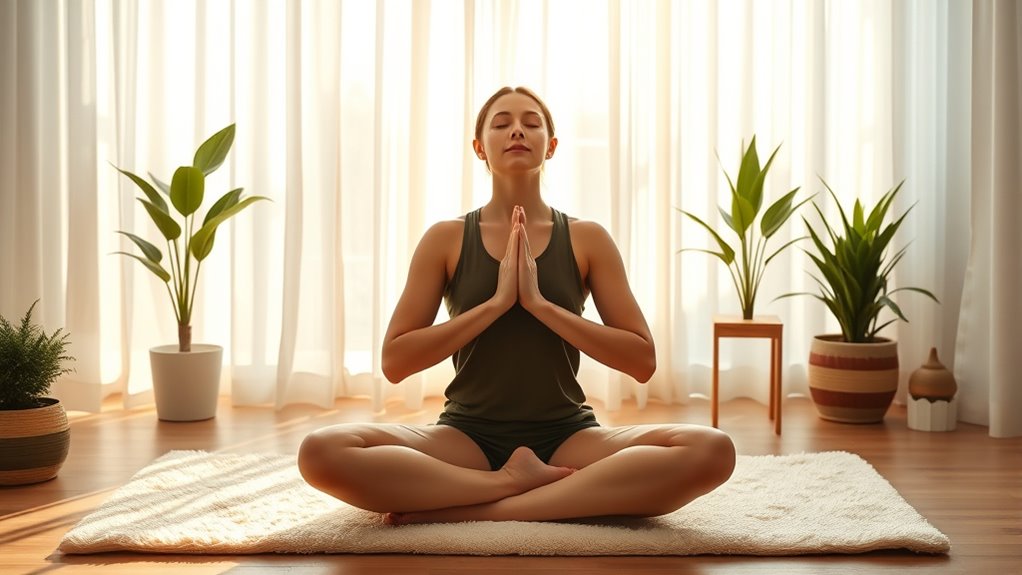To calm anxiety quickly, try mindful breathing techniques like slow, deep breaths through your nose, holding for a count of four, then exhaling gradually. Focus your attention on each breath, expanding your diaphragm and counting rhythmically. This helps reset your nervous system, clear your mind, and bring you into the present moment. Practicing regularly enhances your ability to stay calm in tense situations, and if you stay with it, you’ll discover even more ways to find peace.
Key Takeaways
- Focus on slow, deep breaths through the nose, counting to four for inhalation, hold, and exhalation to promote calmness.
- Practice diaphragmatic or belly breathing to enhance relaxation and reduce anxiety symptoms.
- Use box breathing techniques with equal counts for inhaling, holding, exhaling, and pausing to regulate nervous system response.
- Find a quiet space to consistently concentrate on your breath, redirecting attention from anxious thoughts.
- Incorporate mindfulness by observing each breath without judgment to foster tranquility and mental clarity.

Have you ever wondered how simple breathing exercises can transform your mental clarity and reduce stress? It might surprise you, but this is one of the most effective ways to manage anxiety and find calm amidst chaos. Breathing exercises are straightforward relaxation practices that you can do anytime, anywhere. They help regulate your nervous system, slow your heart rate, and clear your mind. When practiced regularly, these techniques become powerful tools to counteract anxious thoughts and physical tension.
Simple breathing exercises can quickly reduce stress and improve mental clarity anytime, anywhere.
Start by understanding that relaxation practices like mindful breathing are rooted in focusing your attention on your breath. Instead of letting your mind race with worries, you gently guide it back to your breathing pattern. Inhale slowly through your nose, feeling your chest and belly rise as you fill your lungs with air. Exhale gradually through your mouth or nose, releasing tension with each breath. This simple act helps you anchor yourself in the present moment, making it easier to let go of negative thoughts and feelings.
Breathing exercises work best when you approach them with consistency. Dedicate a few minutes each day to practice, ideally in a quiet space where you won’t be disturbed. As you inhale, count to four, then hold your breath for a count of four. Exhale slowly for a count of four, and pause for another count of four before repeating. This rhythmic pattern activates your parasympathetic nervous system, which is responsible for relaxation. Over time, you’ll notice that your body responds more quickly to stress, helping you remain calm in tense situations.
Incorporating relaxation practices like diaphragmatic breathing or box breathing into your routine can deepen your sense of calm. With diaphragmatic breathing, you focus on expanding your diaphragm rather than shallow chest breathing, which often accompanies anxiety. Box breathing involves inhaling, holding, exhaling, and pausing for equal counts, creating a meditative rhythm that calms your mind and body. These techniques are effective because they redirect your focus away from anxious thoughts and onto your breath, fostering a state of mindfulness and tranquility. Additionally, understanding how cookie categories influence your online experience can help you better manage your digital environment and reduce stress related to privacy concerns.
Frequently Asked Questions
Can Mindful Breathing Replace Therapy for Anxiety?
Mindful breathing alone can’t replace therapy for anxiety, as it has limitations and misconceptions. While practicing breathing techniques can help reduce immediate stress, therapy addresses underlying issues and provides personalized strategies. Relying solely on mindfulness may give a false sense of control, but combining it with professional support offers a more thorough approach. You need both tools to manage anxiety effectively, rather than expecting breathing techniques to be a complete substitute.
How Long Should I Practice Mindful Breathing Daily?
You should practice mindful breathing for about 10 to 20 minutes daily. Don’t worry if your breathing duration varies; consistency matters more than length. Even a few minutes each day helps reduce anxiety and builds a calming habit. If you stick with your practice regularly, you’ll notice benefits over time. Remember, short daily sessions are better than infrequent long ones, so keep it simple and stay committed.
Is Mindful Breathing Effective During a Panic Attack?
Yes, mindful breathing is effective during a panic attack. It helps you regain control by focusing on your breathing patterns, which can reduce panic symptom management. When you notice symptoms rising, take slow, deliberate breaths—inhale deeply through your nose, hold briefly, then exhale slowly through your mouth. This simple technique calms your nervous system, easing the intensity of the attack and helping you feel more grounded and in control.
Are There Any Risks or Side Effects?
Mindful breathing is generally safe, but be aware of potential physical risks like dizziness or hyperventilation if you breathe too quickly or deeply. Some people might experience emotional reactions such as frustration or discomfort when focusing inward. To minimize these risks, practice gently, and stop if you feel unwell. If you have underlying health issues, consult a healthcare provider before starting new breathing exercises to guarantee safety.
Can Children Benefit From Mindful Breathing Techniques?
Think of your child’s development as planting a garden; mindful breathing techniques act like nurturing water that calms their mind. Yes, children can benefit greatly from these practices, helping them manage emotions and reduce anxiety. As a parent, incorporating simple breathing exercises into your parenting strategies can foster resilience and emotional regulation, setting a foundation for lifelong mental well-being. Kids learn best through gentle guidance and consistent practice.
Conclusion
Practicing mindful breathing can substantially reduce anxiety—studies show that just a few minutes daily can lower stress levels by up to 40%. By focusing on your breath, you’re giving your mind a break from worries and calming your nervous system. Remember, consistency is key. Incorporate these simple techniques into your routine, and over time, you’ll notice greater peace and clarity. Take a deep breath now—you’re on the path to a calmer, more centered you.








